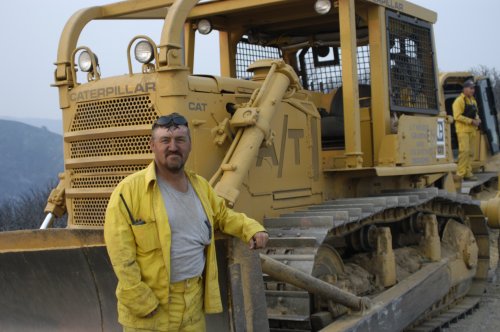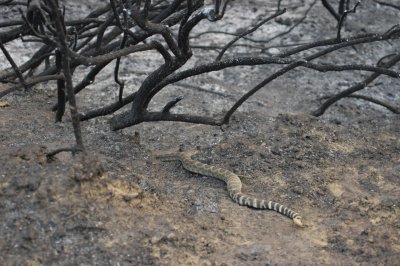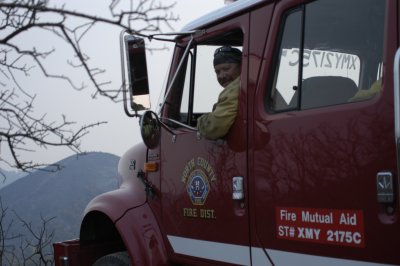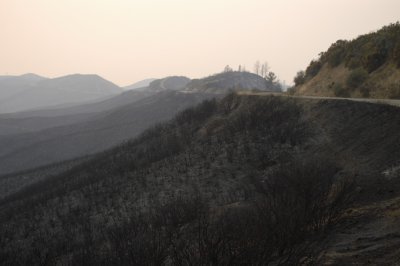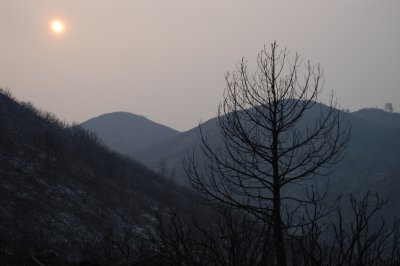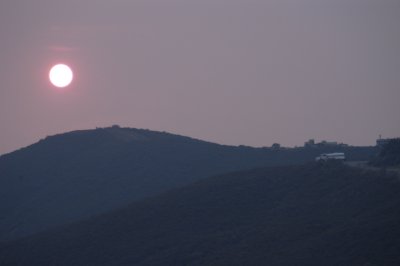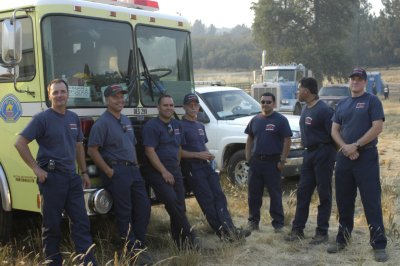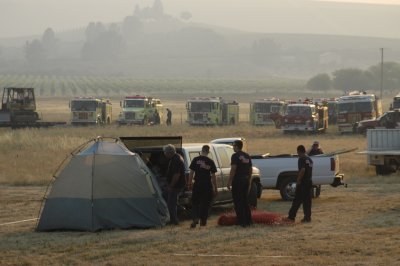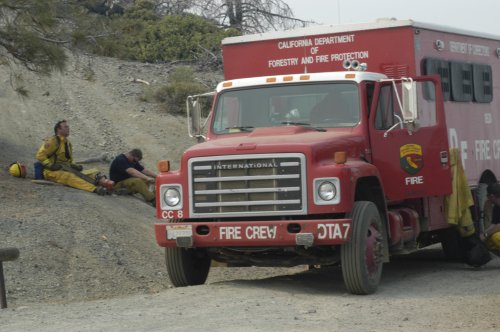
A Cal Fire hand crew winds down for the day on Thursday, June 26, 2008. The firefighters had been working to clean up the burned acreage along Walker Ridge Road. Photo by Elizabeth Larson.
WALKER RIDGE – Fire investigators have concluded that a vehicle was the cause of the Walker Fire, which on Thursday had reached 50-percent containment while making no additional gains in acreage.
Cal Fire Division Chief Dan Sendek said late Thursday that the Walker Fire was still at 14,500 acres in size, located mostly in remote wildland areas about 14 miles east of Clearlake Oaks.
The fire is expected to be fully contained by Saturday, Sendek said.
Originally, it was thought that the Walker Fire was one of hundreds of fires caused by lightning storms last weekend.
However, Sendek said it was sparked when metal – likely on the undercarriage or other metal part on the underside of a vehicle – scraped a rock.
In one day, the fire's containment grew significantly, from 10 to 50 percent containment, which Sendek credited to a lot of bulldozer work over the previous 24 hours, with 31 bulldozers on scene.
The winds were pushing the fire in a north northwest direction, said Sendek.
"With the continuing wind patterns, it doesn't appear to be a direct threat to Spring Valley," he said.
Nor was it a threat to Wilbur Springs, were residents had returned.
Cal Fire reported that residents were being allowed to return to the Double Eagle Ranch subdivision east of Clearlake Oaks, where evacuations had taken place last Sunday.
Sendek said the biggest concern for the Walker Fire was not a wind switch but rather unstable weather, with the possibility of thunder storms in the coming days.
Also on Thursday, the number of firefighting personnel on scene jumped from 592 the day before to 758 – of which 487 were with Cal Fire – with more hand crews arriving, said Sendek.
Late Thursday afternoon, along Walker Ridge Road, a few miles from where it turns to go toward Bartlett Springs, hand crews and bulldozer operators were at work on the steep hillsides, their work difficult to see from the road because of the thick pall of smoke that hung over the hills and valleys.
With the Walker Fire now nearing containment, firefighters and other personnel – including Sendek – are being demobilized and sent to other fires. "We're keeping what we need but not a person more," he said.
Personnel from the Walker Fire are being sent to areas including Butte and Shasta counties, where the fires are threatening communities, said Sendek.
"The big push is on the valley," he said, where the north wind is kicking up and more storms also are expected in the coming days.
Asked how the public can help the firefighting effort, Sendek said the main thing they wanted was the continued support of residents, and that donations were not necessary.
National Forest fires still growing
While the Walker Fire appears to be winding down, lightning-caused fires in the Mendocino National Forest's Upper Lake Ranger District are continuing to grow.
Forest officials reported that four large fires on the Upper Lake District had been broken out from the 49 others on the forest, and are being managed by the Northern Rockies Interagency Incident Management Team.
The fires, located about 15 miles northeast of Upper Lake, include the Big, 850 acres; the Back, 1,800 acres; the Mill, 400 acres; and the Monkey Rock, 450 acres. Thirty structures are threatened, two have been destroyed.
Those fires, referred to as the Soda Complex, total 3,500 acres and are 5-percent contained. Another 385 acres are burning elsewhere in the forest, officials reported. Of the 495 personnel fighting those fires, 412 are committed to the Soda Complex.
The situation also is worsening in neighboring Mendocino County, where 72 fires are actively burning in the Mendocino Lightning Complex, according to county and state officials.
The fires have burned 27,000 acres and are only 5-percent contained, with numerous communities under evacuation warnings and 900 residences threatened, officials reported.

Heavy equipment was working near a Cal Fire repeater along Walker Ridge Road on Thursday, June 26, 2008. Photo by Elizabeth Larson.
Calculating costs and damages
The total cost to fight the Walker Fire is estimated at $1.3 million, compared to $4.7 million for Mendocino County's fires. Sendek said the money to fight the fires comes from the state's Emergency Fund.
Only a hunting cabin in Benmore Canyon, where the fire began, was lost, officials reported.
The Woodland-based Yolo County Flood Control and Water Conservation District, which operates Indian Valley Reservoir, suffered some losses, said General Manager Tim O'Halloran.
The district has a communications tower on Walker Ridge that links it to the reservoir as well as Cache Creek Dam. "On Sunday night, that was overtaken by the fire and all the equipment on it was destroyed," he said.
The equipment destroyed included solar panels, radios, antennas, cabling and a backup generator, he said. They're now working to replace what was lost, and are using temporary satellite service in the meantime.
Damage is estimated at around $75,000, he said, which could double if the communications tower's structural integrity was compromised by the heat.
The fire reached Indian Valley Reservoir, said O'Halloran, where the district temporarily shut down the campground until the situation is stabilized.
O'Halloran said Cal Fire protected the district's water tanks and structures at the campground, including the hold damtender's residence. "The fire got right up to the campground but didn't enter it."
The district worked with Monte Winters, a Lake County Office of Emergency Services liaison who lives in Spring Valley. O'Halloran said Winters kept the district up to date on the fire situation.
O'Halloran said the district was concerned that the fire might reach its hydroelectric plant and a transmission line that goes over the hill to a Pacific Gas and Electric substation. "We were concerned about losing that in the fire," he said.
On Tuesday, district officials shut the power plant off manually due to concerns the fire might reach it, which he said could cause the plant's two operating turbines to trip offline. That, in turn, could have shut off the district's 250 cubic feet per second water release, which could have disrupted water delivery to its water customers.
O'Halloran said Cal Fire allowed district staff into the area to turn off the power and shift the water being released to another outlet.
In the end, the district didn't lose any power lines, nor was service to its water users interrupted, O'Halloran said.
E-mail Elizabeth Larson at This email address is being protected from spambots. You need JavaScript enabled to view it..
{mos_sb_discuss:2}

 How to resolve AdBlock issue?
How to resolve AdBlock issue? 



